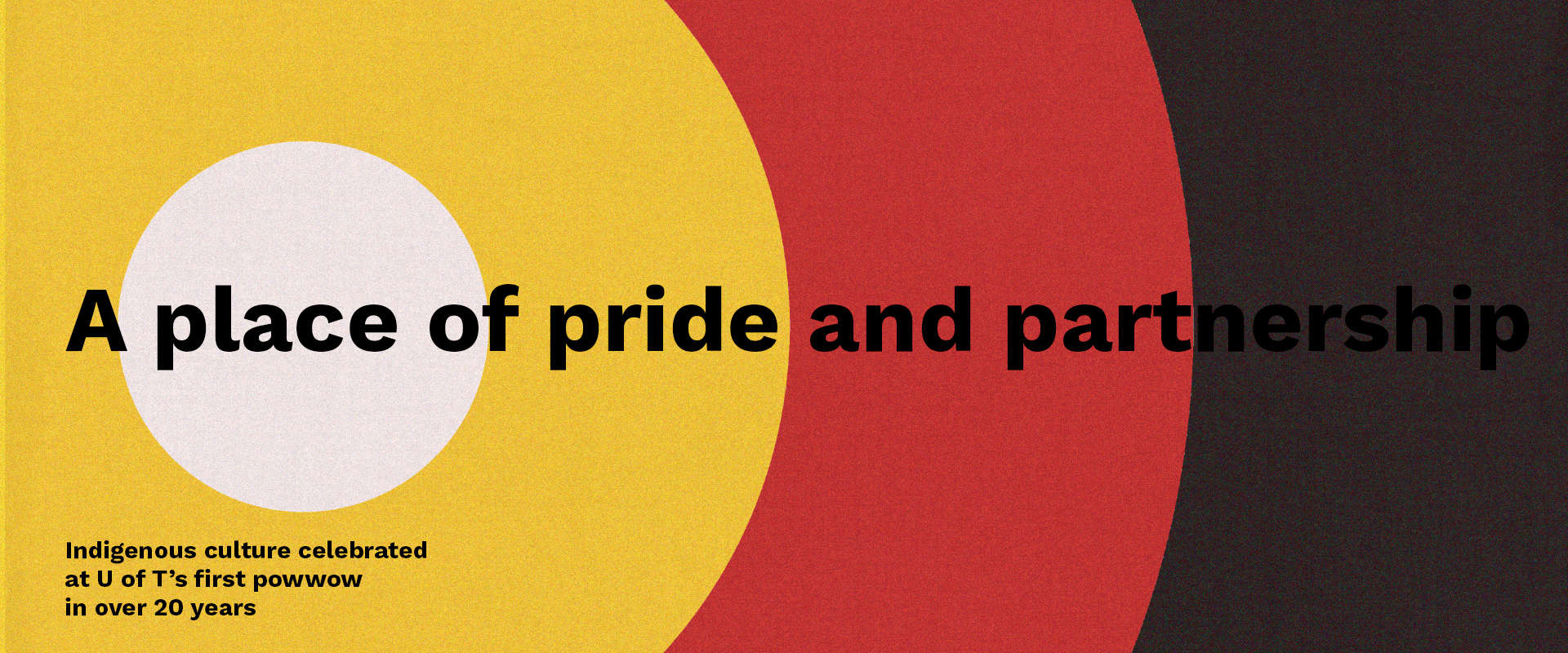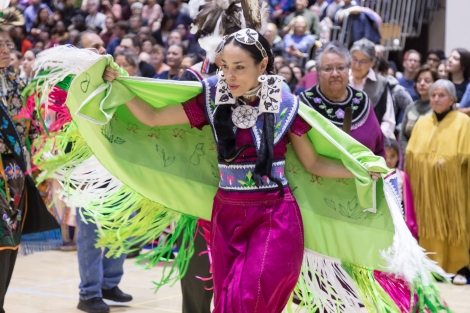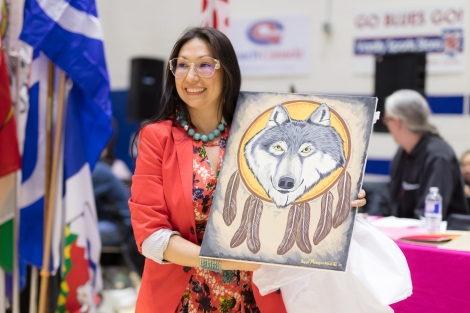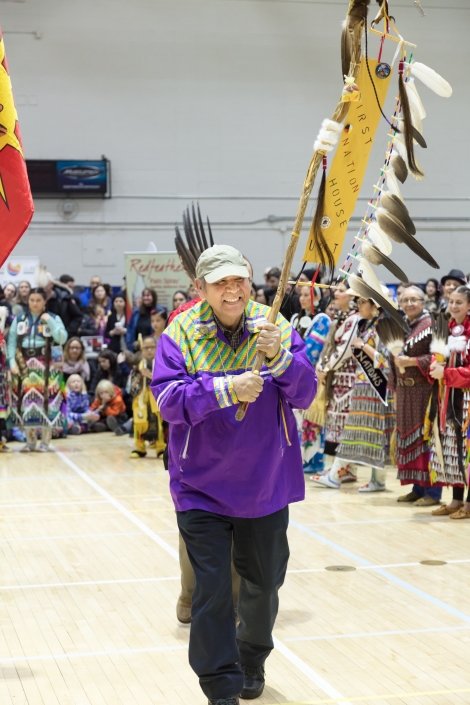As observers trickled into the gymnasium at the Athletic Centre, the excitement was palpable. Families and children began to flood the gym where the Honouring Our Students Indigenous Students Pow Wow and Indigenous Festival would be held.
“In this circle, there is no politics. No religion. We are one,” stated the emcee, his comedic tone momentarily replaced by one of sombre and sincere gratitude.
Vendors displayed their wares at either end of the room, selling paintings, jewellery, and clothing such as moccasins and shirts that read “NATIVE PRIDE.”
All were welcome, as was repeated throughout the day. Decorated in yellow, red, black, and white, the colours of the medicine wheel, the event was made to be inclusive and welcoming, a teaching and learning space for all who entered.
“Over this whole process, overall we’ve had about 20 committee members and also just the partners from the Faculty of Kinesiology to our volunteers, I would say probably close to about 100 people have helped plan this event today,” estimated Jennifer Sylvester, President and Communications Coordinator of the Indigenous Studies Students’ Union (ISSU).
Those volunteers busied themselves as a powwow transformed the gym.
The festivities began with Grand Entry: people entered the circle and bore flags of significance to their communities, including Métis, Mi’kmaq, and the Mississaugas of the New Credit First Nation. Non-Indigenous people also took part, including Minister of Indigenous and Northern Affairs Carolyn Bennett.
Spectators and participants were treated to a variety of traditional dances and performances from Indigenous cultures across North America, which is referred to by many Indigenous people in the Toronto area as Turtle Island. Performances included a Métis jig segment and Aztec dance group COYOTL.
People of all ages and genders were allowed to join in on many of the dances, fostering an environment of inclusion and diversity, which the event’s organizers took great pride in.
“Looking at the crowd down there, there’s a lot of Indigenous people and non-Indigenous people. What’s [important] about having non-Indigenous people here at the powwow is having them see Indigenous cultures and different Indigenous cultures from across Canada,” explained Sylvester.
“So a lot of people have come up to me and they sort of stress that this is the first powwow they have ever been to, and then they’re just so blown away that they never knew the beauty of what a powwow can do for a community,” she said.
Organizing the Powwow
Honouring Our Students began to take shape in July, when Sylvester and the rest of the ISSU decided to make an effort to increase Indigenous presence on campus. Up until November, it was just the ISSU working on the event, but once the planning committee was officially formed and the venue for the event was secured, Sylvester said that was the “cement” they needed to move forward.
“It has been a long process,” Sylvester said of the eight-month-long effort. “The hope [is] that this would become an annual event, for the purpose just so the Indigenous Studies students who are in the program have that ability to transmit or transcend what they learn within a classroom and put it into practice, from the knowledge that they learn from their instructors.”
Sylvester credits the Faculty of Kinesiology & Physical Education with allowing the ISSU to use the gym for the powwow “in kind,” meaning that the rental fee was waived, as a sign of solidarity.
She also said that every college on campus contributed to the organization of the powwow in some monetary form.
“Even unions that are here on campus… Like IATSE 58, they do the theatre houses here, to the United Steelworkers 1998 who are the admin’s representatives here — they’ve given money,” Sylvester said.
As a team, they have asked groups that are part of the university to see if they are willing to help. “And everybody says come back to us next year,” she added.
Jonathan Hamilton-Diabo, Director of First Nations House and Coordinator of the Council of Aboriginal Initiatives, attended the powwow and acknowledged “the hard work of all the students, the dedication, [and] the time that they put in.”
“Considering… all the things they had to work on and pull together, they did a phenomenal job,” Hamilton-Diabo said. “I think it just talks about how talented and gifted our students in our community are.”
Indigenous Presence on Campus
The powwow is just one of many Indigenous initiatives beginning to take place at U of T. Indigenous people are gaining far more publicity and influence on a variety of issues and are taking advantage.
Sylvester describes this as “augmenting the presence” of Indigenous individuals and taking small steps toward claiming space and growing visibility on campus.
Hamilton-Diabo described the powwow as an event that created “a lot of energy… [which] went outside the community as well.”
Not only were Indigenous groups from U of T present, but there were groups from across Canada and North America. The crowd took great pleasure in watching a throat-singing demonstration from an Inuit group, a cultural sharing that truly spoke to the purpose of the event — to foster a positive atmosphere for Indigenous people to proudly be themselves.
Alex McKay is an Associate Professor in Indigenous Studies at U of T who teaches Indigenous language courses, mainly Anishinaabemowin, the traditional language of many Indigenous communities in the northern parts of Ontario. McKay gave the land acknowledgement at the beginning of the powwow, just before Grand Entry, first in Anishinaabemowin, then in English.
“I think it’s great that we have the privilege to host this along with ISSU,” McKay said. “They’re the one’s who made it what it is now. These native people come from all over Turtle Island, and non-Indigenous people become aware because they didn’t learn it in class or in school.”
Federal Minister of Indigenous Affairs Carolyn Bennett spoke with The Varsity about the importance of Indigenous participation on campus and what it means for the government and the future of reconciliation in Canada.
“I think what you see in an event like this is there’s two real benefits. One is that the Indigenous students and families feel proud of their First Nations, Inuit, or Métis status — being a proud Indigenous person,” said Bennett. “We know that that is so linked to self-esteem and resilience and secure personal cultural identity, a safe place to be proudly Indigenous is hugely important.”
The federal government recently committed to honouring all 94 calls to action in the Truth and Reconciliation Commission Final Report.
The ISSU, Centre for Indigenous Studies, First Nations House, and other Indigenous groups on campus have increased their visibility by hosting events like the Pow Wow; places such as the Centre for Indigenous Studies reflect the work being done in the community to better serve Indigenous people.
U of T’s TRC Steering Committee’s Final Report has announced 34 calls to action to build a new relationship with Indigenous communities.
What Comes Next
The end of the powwow left a positive feeling that there would be much more to come for Indigenous events on campus. Sylvester highlighted what it meant to have non-Indigenous people welcome and be part of the event.
“[At the Pow Wow,] knowledge transmits not only within the Indigenous circle but also in the non-Indigenous circle, and therefore it will create this unified effect and the base for reconciliation so you have all these future allies — you have these young leaders who, when they graduate beyond university, they’re able to take what they learn here by the powwow either [by] being on the committee or just attending, and that sticks with you for the rest of your life,” she said.
“They can bring that with them as they move forward.”
Bennett remarked that the powwow was a demonstration of non-Indigenous and Indigenous people coming together to reconcile and better understand the past that was a “pretty dark chapter in Canada’s history.”
“There’s a real presence now of amazing Indigenous people right amongst us… [and] the only way we can go forward is in that partnership, in the Two Row Wampum, in us having the kind of leadership that the Indigenous Studies Students’ Union demonstrated today,” she continued.
The Two Row Wampum was originally an agreement between the Haudenosaunee and Dutch settlers in the seventeenth century. The treaty described two vessels travelling down the same river together, parallel to one-another, each with their own set of laws, customs, and traditions, and never interfering with the other, only living in partnership.
The Two Row Wampum has made its way into contemporary discourse surrounding reconciliation between Indigenous and non-Indigenous peoples. The challenge now lies in working together to achieve and implement a unique traditional worldview. Allowing Indigenous people to have space to honour their culture and gather in a proudly Indigenous manner is just the first step in achieving that relationship.





